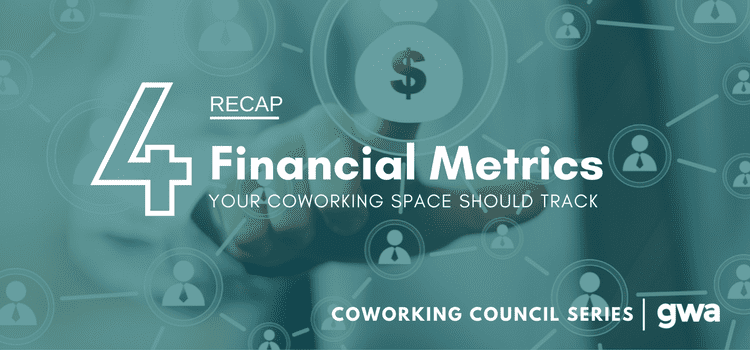Jon Repka, Director of Growth for Paro, an on-demand finance department for small businesses, joined the Global Workspace Association for the latest installment of its virtual event series. This session features experts from a number of specialty areas and backgrounds relevant to coworking spaces. Invitations to webinars as well as full recordings of all past webinars are available to GWA members.
Paro screens and interviews hundreds of bookkeepers, CFOs, and CPAs every week in order to match them to small businesses in need of their services. Small businesses can then use Paro to contract with these professionals on an hourly, on-demand basis, providing a great option for small businesses who want to get a professionally trained set of eyes on their finances without employing a full-time finance professional.
Measuring KPIs for Coworking Spaces
Repka’s presentation centered around the measuring of KPIs for coworking spaces. KPIs—key performance indicators—can be any number of categories for businesses to track and measure. Examples include units sold, monthly revenue, gross margin, client churn, advertising speed, customer acquisition cost, and the lifetime value of the customer.
Repka encouraged coworking space owners to develop a long list of possible categories that could be your KPIs. However, he said it is also important to narrow the KPI list to between 3 and 5 items that you can track over an extended period of time and forecast what-if type scenarios with. More than about five KPIs are usually too much of a burden for businesses to track consistently.
In order to find the KPIs for your business, Repka said to use a control and tweak one variable at a time, tracking what changes there are, if any, based on the variable you adjusted. The ones that have the greatest effect (in reality, not just on paper) on profit are the KPIs you should continue tracking and adjusting your business practices based on.
Tracking KPIs
In order for KPI tracking to be useful, you have to be able to absorb and use the data. Most small businesses do not find tracking KPIs in Excel to be very useful for producing useful, relevant data. Dashboards or even just graphics tend to provide a clearer, more actionable picture of what the business needs to adjust based on tracked KPIs. Repka recommended using at least QuickBooks Online, Xero, NetSuite, or a similar tool to track.
Be sure to track customer data points such as point of sale, CRM, and ERP, as well as website data.
Top KPIs for Coworking Spaces
In addition to an overview of which KPIs to measure, Repka also gave a breakdown of the four top KPIs to track for your business.
KPI #1: Gross Margin
Gross margin is your revenue less cost of goods sold. It is defined as the percentage of total revenue remaining after direct costs to generate revenue are removed.
Practically, gross margin is related to the coworking Cost of Goods (COGS). Examples of COGS include rent (usually the largest COGS), core utilities, parking, and furniture leases. However, the term applies to any expense that is linearly related to adding new tenants.
Gross margin does not include maintenance costs and other costs that remain the same regardless of the number of tenants in your space. You can calculate your gross margin by taking your total revenue and subtracting your COGS, and then dividing that result by total revenue. This will give you an idea of how much profit you are generating per tenant. If you’re not generating gross profit for every tenant you add, you’ll never be able to generate a net profit, Repka explained.
Tracking this KPI (separate of SG&A) can reveal your break-even point as a business and what your gross profit from each tenant is. Over time, it can also show whether your density for your space is high enough for turning a profit, as well as whether your operations are getting more efficient over time.
Finding direction regarding a coworking space’s Gross Margin is difficult as a coworking space’s Cost of Goods Sold (COGS) are most traditional firms’ SG&A.
KPI #2: Net Income
Net income is defined as the percentage of total revenue earned after all expenses are removed, and is often referred to as the bottom line for a business. You can calculate your net income by taking your total revenue and subtracting your COGS as well as your SG&A expenses. SG&A expenses are comprised of sales, marketing, maintenance, payroll, insurance, professional services, travel and entertainment, and similar expense categories.
Probably the most intuitive of the top KPIs, net income is an important number to track because it is the ultimate measure of your business’s profitability. Tracking this consistently can help you analyze whether your business is becoming more or less profitable over time. It also lets you know how much cash you are generating that can be used to expand your business or add more features (and thus more value to the customer) to your coworking space.
Tracking net income also lets you know how new income streams have impacted profitability. For example, have your special events, sponsors, or membership plans positively or negatively affected your income? Or have they had no effect at all?
Adjusting variables slowly while tracking net income can also reveal what business investments have been key in their effect on net income.
KPI #3: Customer Acquisition Cost
Customer acquisition cost (CAC) is comprised of the costs associated with getting a new tenant to sign up for your space. To find your CAC, add up all marketing costs and divide by the number of new tenants added in the same period of time.
In order to calculate CAC, gather data covering sales and marketing spending and divide it by the number of tenants added during the same time period. The time period can flex based on what you believe most accurate for your space (since a delay in customer response can cause a pipeline issue that would skew your data). Repka said the most important thing is to be consistent in how you gather and apply data. That way, you can track trends and how your CAC evolves over time.
The golden ratio, Repka said, is Customer Acquisition Cost to Lifetime Value (LTV). Lifetime value is how much a client will earn over their entire duration as your customer. This can be difficult to calculate since some customers you will be able to upsell into a more highly profitable slot. If you don’t know what percentage of clients ultimately move into a higher priced category, take a guess and then track this number as well, and adjust accordingly. CAC compared to LTV will let you know how profitable each customer is in the long run.
Benchmarking and Platforms
Repka also advised coworking spaces to benchmark profit and key expense categories as a percentage of revenue against other businesses in your industry. He also encouraged coworking spaces to use their KPI information to evaluate how well their personnel, processes, and platforms are working for their spaces.
For the full discussion of KPIs and related tracking practices, join GWA to get access to the entire recording.
This webinar is part of an on-going series available to members of the Global Workspace Association. In addition to invitations to all webinars, which allows for participation in the Q&A sessions, members also have access to recordings of all previous webinars. To view the full version of this webinar, with all the examples, explanation, and Q&A, sign up to become a member. You can join the Global Workspace Association by going here.




